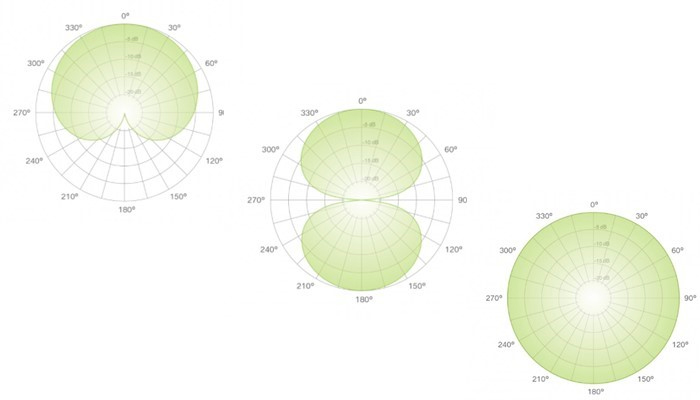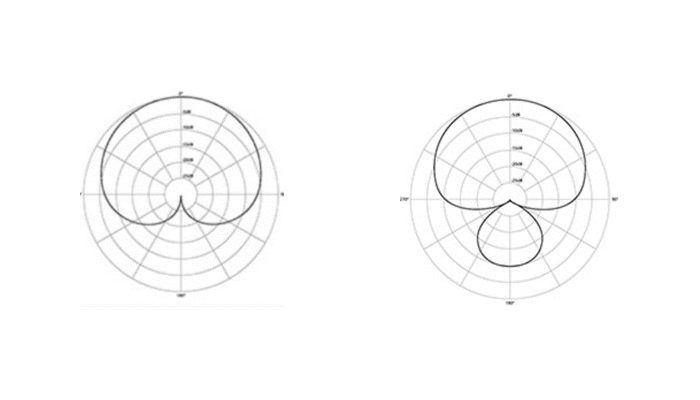When you’re using a microphone, the polar pattern that you choose affects how it picks up and records sound. While there are several types of polar patterns available in microphones today, the most popular type is the unidirectional pattern.
This type of polar pattern is directionally sensitive and picks up sound from one region in space, i.e., in front of the microphone. It’s in contrast, for instance, to omnidirectional microphones that pick up sound from all around the microphone.

In this post, we’ll look at unidirectional microphones, how they work, their pros and cons relative to an omnidirectional polar pattern, and how to use them.
So, if you’re not sure about whether to choose a directionally sensitive microphone for your next live gig or recording session, then this post is for you!
Unidirectional microphones, also referred to as directional microphones, pick up sound from one direction, i.e., they have a polar pattern (see below) that’s designed to focus on sound coming from a particular direction while excluding sounds from other directions.
They are in contrast to omnidirectional microphones that pick up sound from several directions at a time. As such, they are preferred in situations where a single sound source is the focus of live audio or recording sessions without picking up too much ambiance or background noise.
Microphone polar patterns—also referred to as microphone pickup patterns—describe the region from which a microphone picks up sound. There are several types of polar patterns used in modern microphones, with the most popular being the directional types.
The most common types of polar patterns are:

Keep in mind that a microphone’s polar pattern is about more than just its positioning relative to a sound source—as Paul White, accomplished audio industry veteran, puts it:
While the cardioid polar pattern is the most common type of directional pattern (positioned back-to-back in the case of a bi-directional pattern), there are other variations used:

Both the super and hyper-cardioid patterns provide a narrower region of front-focus than the cardioid, and as such, they’re useful in situations when you want less ambient noise and strong directionality, albeit with some pickup from the rear. They require careful positioning, however—if a singer or speaker were to move off-axis during a recording, your sound quality may be impacted.
The sub-cardioid is less focused than the super and hyper variants, is better suited for a wide sound source, and provides a more natural, open sound. It is, however, more susceptible to feedback given the more open nature of this pickup pattern.
The directionality of a microphone is determined by the design of its capsule, i.e., the part that contains the sound-sensitive mechanism, usually consisting of a diaphragm that vibrates in response to sound waves.
There are two primary types of capsule design:
Pressure capsules are used in omni mics as they respond to sound coming from all directions.
Pressure-gradient capsules are used in directional mics, as the size of the gradient varies according to the angle of the sound source, making these microphones sensitive to directionality.
One of the main advantages of a directional microphone is its focused pickup region. This means that it won’t pick up unwanted sounds or background noise.
This is useful in situations where sound is coming from a narrow region relative to the mic, such as during a speech or lecture, or if there’s a band directly in front of your mic.
Other advantages of unidirectional mics include:
A major disadvantage of a directional microphone is its proximity effect, i.e., the impact on its frequency response as it moves closer to a source of sound. This results in an excessive bass response when it’s close to the source.
A singer, for instance, would notice a higher bass response as they move closer to a directional microphone due to the proximity effect. This may be desirable in some situations, if the additional bass adds a deep, earthy tone to the singer’s voice, for example, but is undesirable when a consistent tonal balance is required.
Other disadvantages of directional mics include:
The way that a directional microphone is made, i.e., to generate its directional polar pattern, results in certain characteristics that are worth being aware of when you use one. Let’s look at two of the most important of these.
Omnidirectional mics are known for their consistent sensitivity across a wide range of frequencies, but for a directional mic, the pressure-gradient mechanism means that it has different sensitivities at low vs high frequencies. In particular, it’s almost insensitive at low frequencies.
To combat this, manufacturers make the diaphragm of a directional mic much more responsive to low frequencies. However, while this helps to combat the tendencies of the pressure-gradient mechanism, it results in susceptibility to unwanted low-frequency sounds arising from vibrations, handling noise, wind, and popping.
A property of sound waves is that their energy at low frequencies dissipates much more rapidly than at high frequencies, and this varies with proximity from the source. This is what causes the proximity effect.
Given this effect, manufacturers design a directional mic’s frequency characteristics with certain proximity in mind. In use, if the distance to the source differs from what it’s designed for, the mic’s tonal response may sound overly “boomy” or “thin”.
With these characteristics in mind, here are a few best-practice techniques to adopt when using a directional microphone:
Still not sure which mic to choose? We prepared a comprehensive guide where we compare unidirectional vs omnidirectional microphones in details!
In this post, we’ve looked at unidirectional microphones, i.e., those that have a directional polar pattern. Compared with a non-directional (omnidirectional) polar pattern, these microphones feature:
Given their characteristics, the next time you’re choosing a mic for a situation in which directionality matters, e.g., when an omnidirectional pickup pattern would result in too much ambient noise, a directional mic may be just the one that you need.